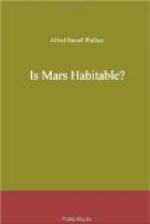Dimensions of the Canals.
A few dimensions of these strange objects must be given in order that readers may appreciate their full strangeness and inexplicability. Out of more than four hundred canals seen and recorded by Mr. Lowell, fifty-one, or about one eighth, are either constantly or occasionally seen to be double, the appearance of duplicity being more or less periodical. Of ‘canals’ generally, Mr. Lowell states that they vary in length from a few hundred to a few thousand miles long, one of the largest being the Phison, which he terms ‘a typical double canal,’ and which is said to be 2250 miles long, while the distance between its two constituents is about 130 miles.[3] The actual width of each canal is from a minimum of about a mile up to several miles, in one case over twenty. A great feature of the doubles is, that they are strictly parallel throughout their whole course, and that in almost all cases they are so truly straight as to form parts of a great circle of the planet’s sphere. A few however follow a gradual but very distinct curve, and such of these as are double present the same strict parallelism as those which are straight.
[Footnote 3: This is on the opposite side of Mars from that shown in the frontispiece.]
Canals extend across the Seas.
It was only after seventeen years of observation of the canals that it was found that they extended also into and across the dark spots and surfaces which by the earlier observers were termed seas, and which then formed the only clearly distinguishable and permanent marks on the planet’s surface. At the present time, Professor Lowell states that this “curious triangulation has been traced over almost every portion of the planet’s surface, whether dark or light, whether greenish, ochre, or brown in colour.” In some parts they are much closer together than in others, “forming a perfect network of lines and spots, so that to identify them all was a matter of extreme difficulty.” Two such portions are figured at pages 247 and 256 of Mr. Lowell’s volume.
The Oases.
The curious circular black spots which are seen at the intersections of many of the canals, and which in some parts of the surface are very numerous, are said to be more difficult of detection than even the lines, being often blurred or rendered completely invisible by slight irregularities in our own atmosphere, while the canals themselves continue visible. About 180 of these have now been found, and the more prominent of them are estimated to vary from 75 to 100 miles in diameter. There are however many much smaller, down to minute and barely visible black points. Yet they all seem a little larger than the canals which enter them. Where the canals are double, the spots (or ‘oases’ as Mr. Lowell terms them) lie between the two parallel canals.




